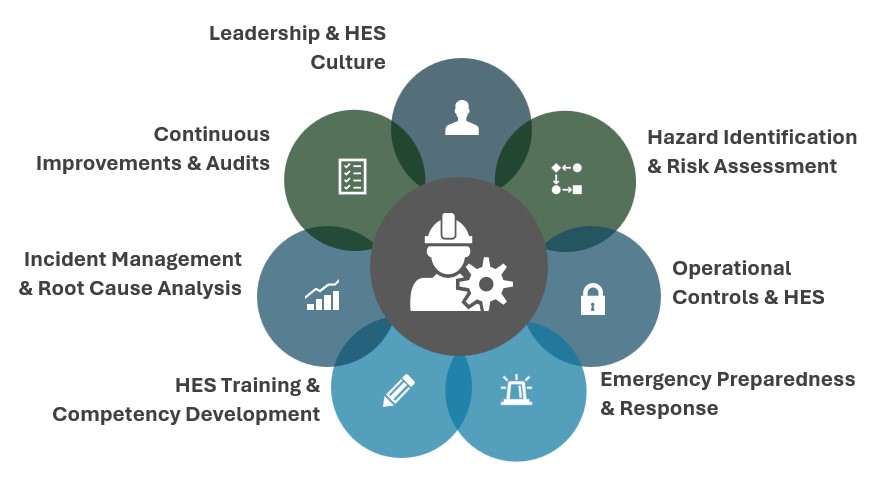The Health, Environment, and Safety (HES) domain is foundational to industrial operations, safeguarding both people and the planet while ensuring compliance with rigorous regulatory frameworks. Despite considerable efforts, HES continues to face significant challenges—from navigating complex regulations and managing extensive documentation to ensuring worker safety in dynamic environments. These challenges are further amplified by the influx of a younger, technologically adept workforce that may lack deep operational and risk management experience. To keep pace, HES tools and approaches must evolve, fostering an adaptive safety culture that anticipates and meets future needs.
Generative AI can serve as a powerful catalyst in helping companies make this transition. By generating contextual insights, simplifying knowledge retrieval, and personalizing training and communication, Generative AI directly addresses key HES challenges. Let’s explore how Generative AI can transform HES practices and drive meaningful impact across key elements of the HES framework outlined below.

Generative AI Use Cases
1. Streamlined HES Procedure Search & Retrieval
Workers often struggle to sift through extensive HES manuals and procedures, especially in time-critical situations. Generative AI can power intelligent, natural language-based search tools that instantly retrieve the most relevant safety procedures. These contextual, role-specific retrievals can significantly improve engagement and response times, while also reducing the likelihood of human error in critical moments. By incorporating voice-based search and mobile-friendly interfaces, these tools ensure accessibility even for workers in remote or hands-on environments. Furthermore, AI-driven analytics can identify frequently accessed procedures or common query patterns, enabling organizations to refine and prioritize safety training materials.
2. Enhanced Historical Data Classification and Enrichment
HES teams often analyze years of historical data—including observations, incidents, and compliance records—to draw conclusions and fulfill regulatory requirements. We now have the capability to consistently classify and label this largely text-based dataset, with minimal effort. This will enable us to better understand correlations with factors such as weather, workforce experience, and the broader operating environment – making the dataset far richer for predictive analytics, likely leading to insights that have been illusive in the past. Overall, this will give organizations the ability to anticipate and mitigate risks before they occur.
3. Personalized, Context-Aware Safety Briefings
On-site workers frequently receive generic safety briefings that may lack relevance to their specific environment or tasks. Generative AI can deliver highly personalized, localized safety messages that consider the type of task, location, current weather, and recent observation/incident history. This makes safety communications more relevant, engaging, and impactful, fostering a culture of proactive safety. Additionally, these AI-generated messages can be delivered in multiple formats, such as real-time alerts or pre-shift briefings, ensuring they are timely and actionable.
4. Leading Indicator and Trend Analysis
HES is evolving from focusing on traditional lagging indicators, like injury rates, to leading indicators that signal potential risks early on. Generative AI can analyze trends in near-miss reports, equipment failures, or safety observations to identify subtle leading indicators. This gives safety managers real-time insights into emerging risks, enabling proactive mitigation before issues escalate. By visualizing these insights through intuitive dashboards or alert systems, it ensures that critical information is easily actionable.
5. Continuous Facility Operational Safety Assessment
Assessing operational safety in a facility is traditionally a labor-intensive, periodic activity involving extensive process and data, led by HES and Operations teams. Generative AI can interpret real-time data from audio, video, and other sensors to provide ongoing safety assessments that complement human observation. This shifts facility safety management from manual audits to continuous monitoring, enhancing overall safety resilience. Over time, the system can also learn from incident outcomes to fine-tune its risk-detection algorithms, driving continuous improvement in safety protocols.
6. Engaging HES Training Content Development
Training is central to HES, but developing comprehensive and engaging training content is resource intensive. Generative AI can help create immersive training materials, including realistic scenarios, customized case studies, and interactive modules. AI-generated content keeps the workforce engaged, improving knowledge retention while making HES education more consistent and scalable. For example, creation of short videos simulating real-life workplace scenarios like addressing a minor spill or usage of appropriate PPE in hazardous conditions.
7. ESG Rating Improvement Opportunities
HES also intersects with broader Environmental, Social, and Governance (ESG) objectives. Many organizations are working to improve their ESG ratings, and Generative AI can help by identifying opportunities to boost sustainability and compliance efforts. By analyzing ESG scoring methodologies and comparing detailed scores with industry peers, AI can highlight specific actions that lead to improved ESG performance.
8. Emissions Management
Traditional emissions management relies heavily on periodic reporting and manual calculations, often missing near-time changes in emissions profiles. Generative AI can process data from IoT sensors, satellite imagery, and operational logs to provide continuous insights into emissions across facilities. This enables proactive adjustments to operational parameters to stay within compliance limits while optimizing efficiency.
Conclusion: Paving the Way for a Safer Future
Generative AI offers a transformative opportunity to elevate Health, Environment, and Safety practices to new levels of efficiency and impact. By harnessing these capabilities, organizations can create safer workplaces, empower a more informed workforce, and make meaningful progress towards a healthier, safer future.
The tools are ready; it’s time to use them to build an agile, informed, and resilient HES culture.
At Ententia, we are currently developing a focused HES solution leveraging Generative AI. We invite industry partners to join us in co-creating the solution that not only tackles today’s challenges but also shapes the future of safe and responsible operations.
Connect with us at info@ententia.ai for opportunities to collaborate or learn more.